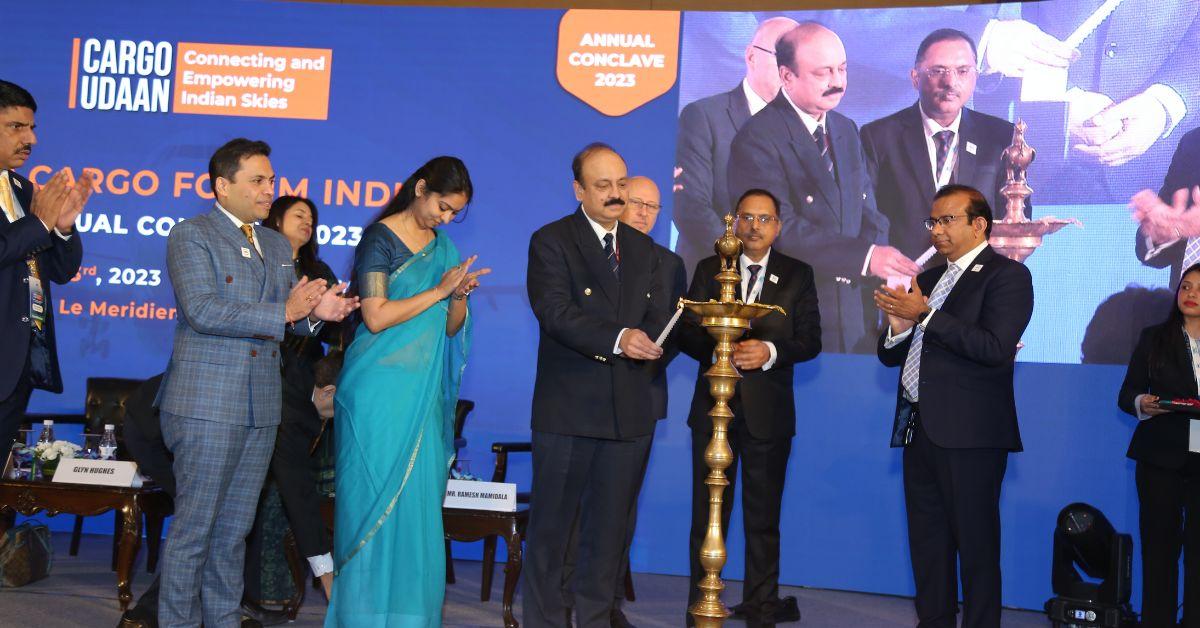The Air Cargo Forum India (ACFI), which was created for promotion of the growth of the air cargo industry in India, organized its annual conclave 2023, recently in the capital to a packed audience. The huge turnout was a testament to the importance of the event and the interest the conclave had generated in the logistics world. The event attracted policy makers, industry leaders and other stakeholders in the supply chain. The theme of the conclave was Cargo Udaan – Connecting and Empowering Indian Skies.
The theme of the conclave was relevant for two reasons. Firstly, the conglomerates across the world were treading carefully when it came to reliance on manufacturing activities in China. The China-Plus-One strategy was an opportunity for India to step forward and showcase its prowess in the manufacturing sectors. Secondly the Government of India’s push to establish airports across the country, was certainly conducive to empowering the Indian skies.
The business session’s keynote address was kicked off with a scintillating talk by Glyn Hughes, Director General, The International Air Cargo Association (TIACA). He referred to the giant strides made by airlines during the pandemic period. Canadian pork belly exports traditionally moved by ships from Vancouver to Asian markets that had a transit time of 28 days. However, during the pandemic, due to paucity of capacity in the ships, the exports of the product was affected. An airline offered to charter a plane to carry the product. The transit time was just 14 hours. The transaction was found to be profitable. Hughes explained that what the air cargo industry does is that enables it to derive additional value from the products that are already being moved.
Piyush Srivastava, Senior Economic Advisor, Ministry of Civil Aviation, said that 31 domestic airports had cargo facilities. Of which 21 airports had cold storage facilities. Thirteen terminals had international cargo facilities. Ten airports had state of the art facilities. He further urged the airline industry to take part in the Krishi Udaan scheme, meant for perishable cargo. He urged the industry to come forward with ideas.
Jivisha Joshi, Deputy Secretary – Logistics, Department for Promotion of Industry, and Internal Trade (DPIIT), Ministry of Commerce and Industry, focussed on PM Gati Shakti. She clarified when one ministry was planning anything, it must be well integrated with what other ministries are doing. She clarified that the PM Gati Shakti aimed at two things viz, to bring multi-modality and also about timely synchronized execution of projects. the country had improved upon the Logistics Performance Index. The maximum improvement was achieved in the logistics efficiency.
She stated that Unified Logistics Interface Platform (ULIP) had the potential to become the UPI for logistics, i.e. a single window mobile payment system launched by the National Payments Corporation of India. Joshi further added that the Government was trying to create a database which would be freely available to the industry to develop applications for industry usage.
With regard to the logistics costs, the government was striving to arrive at a ballpark figure of the logistics cost. They were working on a methodology to arrive at this figure each year – identify where it was increasing or decreasing.
In the first business session, the moderator Satish Lakkaraju, asked Dr. Sudhanshu, Secretary, Agricultural & Processed Food Products Export Development Authority, (APEDA), as to what APEDA expected from the airline industry. Dr. Sudhanshu felt that the overall strength of the supply chain needed to be strengthened. Unless the loose ends were identified and plugged, the quality of the product would be affected. This would inevitably affect the brand image of the country.
Kunal Bhatt, Consultant Cargo, Commercial, TATA Air India, said that Air India had placed orders for 470 aircrafts which indicated that it wanted to develop a customer and cargo industry. Of these aircrafts, 70 were cargo friendly. Further he also felt that there was a need to address the regulatory framework that was inhibiting progress in the air cargo industry.
Vipul Bhatia, Chief Business Officer, Pradhaan Air Express felt that in the coming times there would be improvement in the supply chain; improvement in the make in India programme and improvement in manufacturing. They were bullish about the cargo business and about brand India. They had intentions to bring in wide bodied freighters in 2025. They knew international carriers would feel the pinch, because a home-grown Indian carrier was now stepping into their space.
Arun Chandra, assistant Vice President – Aviation Business, Bangalore International Airport Limited, said that despite the headwinds, they were able to maintain their share of air cargo of 13%. Looking ahead he felt that the forecast was bullish for the air cargo industry. However, some of the challenges would continue to remain. They were looking to expand their cargo terminals. They were also developing a new domestic cargo terminal and a logistic park.
On the question of what role airports can play in catalysing the growth of international cargo, he said that firstly there should be the right kind of infrastructure and capacity building. Most of the airports in India were focussed in creating this capacity. Secondly, embrace innovation and technology such as block chain, AI, IOT etc. It was already evident with automation the cargo growth had fast tracked that has created an era of e-commerce that was a key force in the growth of air cargo as well. Thirdly all this growth has to come with sustainability at its core. Initiatives need to be taken to reduce emissions, noise and CO2, in line with international standards and practices.
Ramesh Mamidala, Head Cargo commercial, Air India Limited also said that they would be inducting a number of wide-bodied aircrafts into operations. In the next couple of years there would be not only growth in terms of volume, but also a lot of manufacturing for exports in the country. They also see many trade partners adopting new technology to gain efficiency and reduce costs.
The final session of the day was on domestic air cargo focussing on leveraging the potential of Indian domestic cargo. Dr Ravi Mathur, Vice President And Global Head of Logistics and Supply Chain Excellence, Dr. Reddy’s Laboratories Ltd, was of the opinion that air cargo instead of being a facilitator ended up by being a constraint in the entire supply chain. He said that many airports were being constructed around the country and the last mile connectivity should be a part of the blueprint. Customer centricity should be the focus in air freight.
Ajith Pai, Chief Operating Officer, Delhivery Pvt Ltd, said that 8 years ago, they were transporting 150,000 shipments a day. In comparison to the present time while the overall business had increased 13x in the last 7 years, the total tonnage by air cargo had increased only by approximately 2%. This was because it was only in mode of transport where end to end had increased in the last 10 years and not decreased. This was because of increased constraints in the supply chain. The effective timeline in other modes of transport had increased. Further in air cargo there is a major constraint in information flow. Different stakeholders have their own systems which work in silos. Although the information is there, it is not available to the customers.
Kamal Hingorani, Chief Officer – Cargo, SpiceJet Ltd, said that they continued to focus on air cargo. They were in the process of acquiring several air freighters for domestic movement, despite the fact that international freight movement to Asian countries was more lucrative. The biggest challenge they faced was the cost of fuel. There was also a need to improve the infrastructure across the supply chain.
Gaurav Ghuwalewala, Executive Committee Member, Domestic Air Cargo Agents Association (DACCAI), said that in domestic cargo there was a lot of movement of seasonal cargo. It was not possible to immediately create infrastructure to cater to this seasonal cargo. But some kind of green channel needs to be created, so that the cargo moves without hindrance. Further there is a requirement for a cargo community system that enables each stakeholder to be on the same platform.









